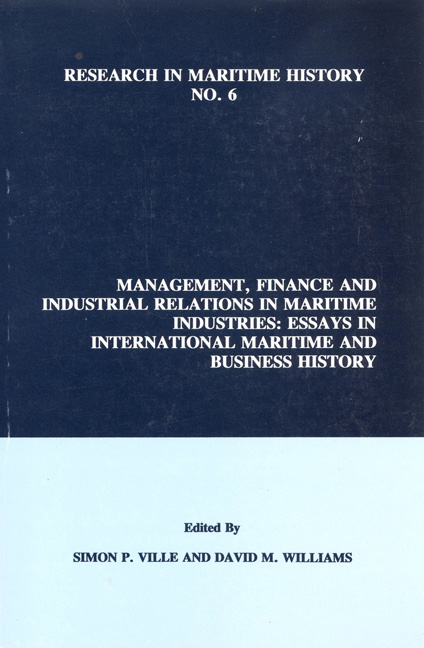 Management, Finance and Industrial Relations in Maritime Industries
Management, Finance and Industrial Relations in Maritime Industries from Contributors
In the interwar period Italian shipbuilders were financially weakened by conflicts among banks, iron and steel companies, and shipping firms, all of whom sought to control the yards and to reduce the industry's excess capacity. In this struggle for survival the most efficient yards were not always the winners. Until about 1923 “natural selection” was at work among the medium-sized shipbuilding companies not linked to the banks, but it did not resolve the problem. Nor did the many financial adjustments of the late 1920s aimed at averting the bankruptcy of large firms and the subsequent transfer of their losses to the banks. Before 1930 the big banks were unable to rationalize the industry. Although effective planning might have succeeded, it did not occur because the banks were more concerned with supremacy; in this struggle, the yards occupied a subordinate position. The creation of a sound maritime sector thus failed, and after the Great Slump the state replaced bank control, especially in shipbuilding, with IRI, a public holding company. While IRI restructured other sectors, it was less successful in shipbuilding.
An examination of the main Italian yards reveals two key features: the critical position of some twenty large shipbuilding companies, the weakest link in a production chain stretching from steel producers to shipowners; and a conflict between managers, keen to improve the quality and efficiency of ship production, and leading banks, which refused to surrender control to competitors in steel, engineering or shipping. These traits explain the over-lending by banks associated with the two principal groups of shipyards. During the 1920s rival conglomerates headed by the two main mixed banks, Banca Commerciale and Credito Italiano, reorganised to try to achieve full integration. But such achievements were limited. In shipbuilding, each bank controlled a group of yards, but because they were incompletely integrated (while some were linked with engineering firms, ties with steel companies were only partial) the banks were compelled to provide funds to support their industrial strategies. Shipbuilding companies thus became sufficiently debt-ridden that they could not be allowed to fail.
To save this book to your Kindle, first ensure no-reply@cambridge.org is added to your Approved Personal Document E-mail List under your Personal Document Settings on the Manage Your Content and Devices page of your Amazon account. Then enter the ‘name’ part of your Kindle email address below. Find out more about saving to your Kindle.
Note you can select to save to either the @free.kindle.com or @kindle.com variations. ‘@free.kindle.com’ emails are free but can only be saved to your device when it is connected to wi-fi. ‘@kindle.com’ emails can be delivered even when you are not connected to wi-fi, but note that service fees apply.
Find out more about the Kindle Personal Document Service.
To save content items to your account, please confirm that you agree to abide by our usage policies. If this is the first time you use this feature, you will be asked to authorise Cambridge Core to connect with your account. Find out more about saving content to Dropbox.
To save content items to your account, please confirm that you agree to abide by our usage policies. If this is the first time you use this feature, you will be asked to authorise Cambridge Core to connect with your account. Find out more about saving content to Google Drive.